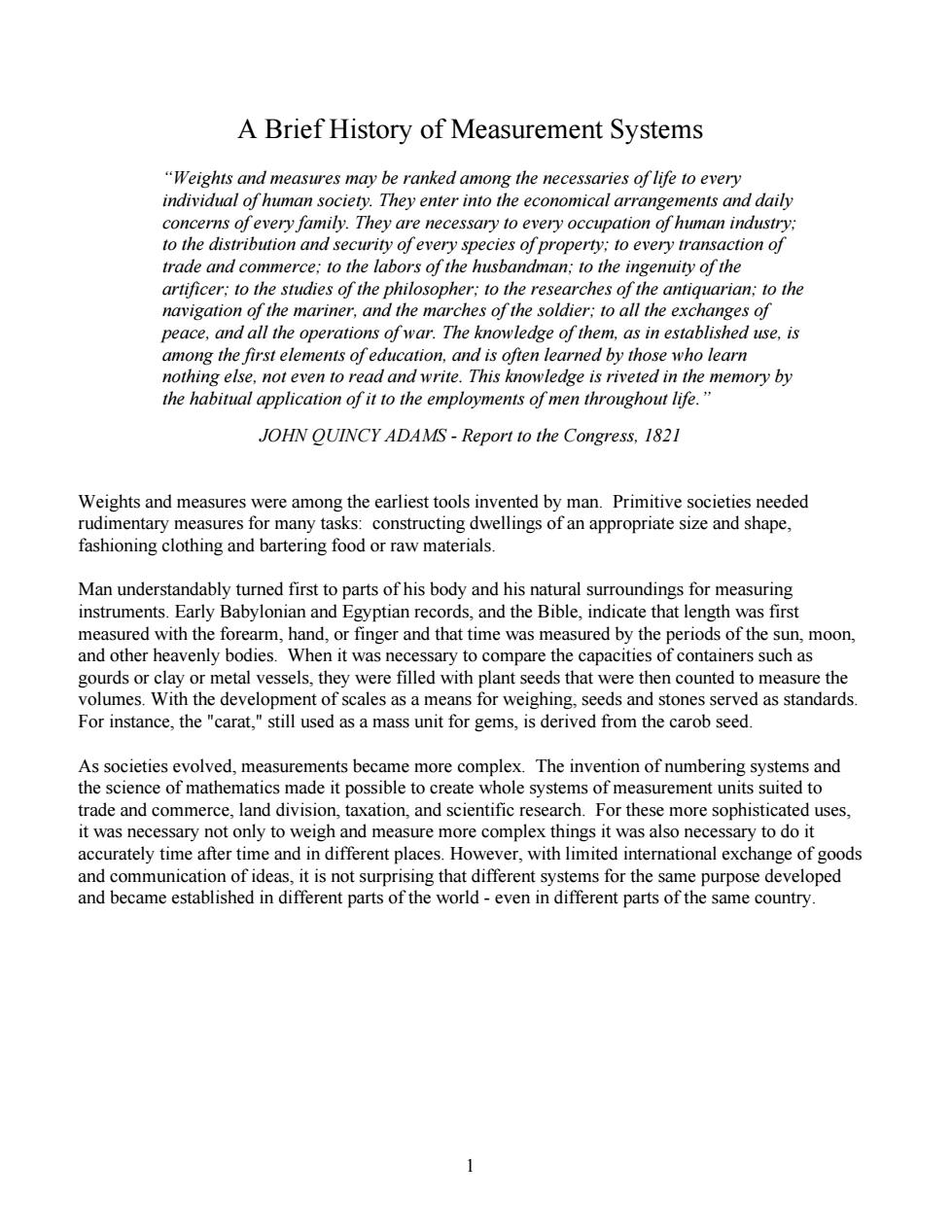正在加载图片...

A Brief History of Measurement Systems "Weights and measures may be ranked among the necessaries of life to every individual of human society.They enter into the economical arrangements and daily concerns ofevery family.They are necessary to every occupation of human industry; to the distribution and security ofevery species of property;to every transaction of trade and commerce;to the labors of the husbandman;to the ingenuity of the artificer;to the studies of the philosopher;to the researches of the antiquarian;to the navigation of the mariner,and the marches of the soldier;to all the exchanges of peace,and all the operations of war.The knowledge of them,as in established use,is among the first elements ofeducation,and is often learned by those who learn nothing else,not even to read and write.This knowledge is riveted in the memory by the habitual application of it to the employments of men throughout life." JOHN QUINCY ADAMS-Report to the Congress,1821 Weights and measures were among the earliest tools invented by man.Primitive societies needed rudimentary measures for many tasks:constructing dwellings of an appropriate size and shape, fashioning clothing and bartering food or raw materials. Man understandably turned first to parts of his body and his natural surroundings for measuring instruments.Early Babylonian and Egyptian records,and the Bible,indicate that length was first measured with the forearm,hand,or finger and that time was measured by the periods of the sun,moon, and other heavenly bodies.When it was necessary to compare the capacities of containers such as gourds or clay or metal vessels,they were filled with plant seeds that were then counted to measure the volumes.With the development of scales as a means for weighing,seeds and stones served as standards. For instance,the "carat,"still used as a mass unit for gems,is derived from the carob seed. As societies evolved,measurements became more complex.The invention of numbering systems and the science of mathematics made it possible to create whole systems of measurement units suited to trade and commerce,land division,taxation,and scientific research.For these more sophisticated uses, it was necessary not only to weigh and measure more complex things it was also necessary to do it accurately time after time and in different places.However,with limited international exchange of goods and communication of ideas,it is not surprising that different systems for the same purpose developed and became established in different parts of the world-even in different parts of the same country. 1A Brief History of Measurement Systems “Weights and measures may be ranked among the necessaries of life to every individual of human society. They enter into the economical arrangements and daily concerns of every family. They are necessary to every occupation of human industry; to the distribution and security of every species of property; to every transaction of trade and commerce; to the labors of the husbandman; to the ingenuity of the artificer; to the studies of the philosopher; to the researches of the antiquarian; to the navigation of the mariner, and the marches of the soldier; to all the exchanges of peace, and all the operations of war. The knowledge of them, as in established use, is among the first elements of education, and is often learned by those who learn nothing else, not even to read and write. This knowledge is riveted in the memory by the habitual application of it to the employments of men throughout life.” JOHN QUINCY ADAMS - Report to the Congress, 1821 Weights and measures were among the earliest tools invented by man. Primitive societies needed rudimentary measures for many tasks: constructing dwellings of an appropriate size and shape, fashioning clothing and bartering food or raw materials. Man understandably turned first to parts of his body and his natural surroundings for measuring instruments. Early Babylonian and Egyptian records, and the Bible, indicate that length was first measured with the forearm, hand, or finger and that time was measured by the periods of the sun, moon, and other heavenly bodies. When it was necessary to compare the capacities of containers such as gourds or clay or metal vessels, they were filled with plant seeds that were then counted to measure the volumes. With the development of scales as a means for weighing, seeds and stones served as standards. For instance, the "carat," still used as a mass unit for gems, is derived from the carob seed. As societies evolved, measurements became more complex. The invention of numbering systems and the science of mathematics made it possible to create whole systems of measurement units suited to trade and commerce, land division, taxation, and scientific research. For these more sophisticated uses, it was necessary not only to weigh and measure more complex things it was also necessary to do it accurately time after time and in different places. However, with limited international exchange of goods and communication of ideas, it is not surprising that different systems for the same purpose developed and became established in different parts of the world - even in different parts of the same country. 1